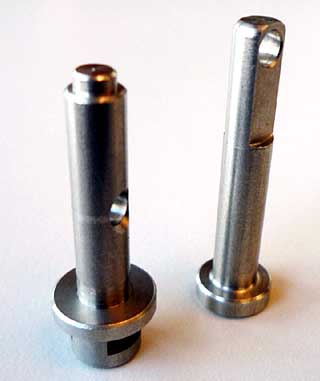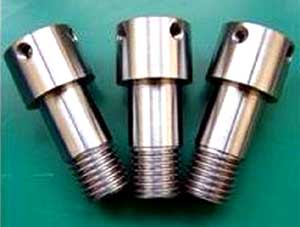Stainless Steel Rust Causes
When brown rust (spots) appear on the surface of stainless steel bearings,
People are greatly surprised: "Stainless steel bearings do not rust, and rust is not a stainless steel bearing. It may be a problem with steel." In fact, this is a one-sided misconception about the lack of understanding of stainless steel bearings. Stainless steel bearings will rust under certain conditions.
Stainless steel bearings have the ability to resist atmospheric oxidation - that is, stainless, but also have the ability to resist corrosion in media containing acid, alkali, and salt - that is, corrosion resistance. However, the corrosion resistance of the steel varies with the chemical composition of the steel itself, the mutual state, the conditions of use, and the type of environmental media.
Such as 304 steel pipe, in the dry clean atmosphere, there is absolutely excellent resistance to corrosion, but it will be moved to the sea area, in the sea fog containing a lot of salt, will quickly rust; However, 316 steel pipe performed well.
Therefore, not any kind of stainless steel, are resistant to corrosion in any environment, it does not rust. Stainless steel is a very thin and strong and stable chromium-rich oxide film (protective film) formed on its surface. Prevent the continued penetration of oxygen atoms, continue to oxidize, and get the ability to resist rust. Once for some reason, this kind of film has been continuously destroyed, and oxygen or oxygen atoms in the air will continuously infiltrate. Or the iron atoms in the metal are continuously separated out to form loose iron oxides, and the metal surface is constantly rusted. There are many forms of this surface film that are damaged.
Common causes of stainless steel rust, there are the following:
1. The surface of stainless steel contains deposits of dust or other dissimilar metal particles containing other metal elements. In humid air, the condensed water between the attached matter and the stainless steel connects the two into a micro-resistance, which triggers an electrochemical reaction and the protective film is destroyed, which is called electrochemical corrosion.
2. The surface of the stainless steel adheres to organic matter juice (such as melon vegetables, noodles, soup, etc.), and in the presence of water and oxygen, it constitutes organic acids. For a long time organic acids attack the metal surface.
3. Stainless steel surface adhesion contains acid, alkali, salt substances (Alkaline water on the wall, lime water splashes), causing localized corrosion.
4. In contaminated air (such as atmospheres containing large amounts of sulfides, carbon oxides, and nitrogen oxides), In case of condensation water, sulfuric acid, nitric acid, and acetic acid liquids are formed, causing chemical corrosion.
solution:
SUS440C This steel is martensitic stainless steel, the carbon content is higher than 3cr13 steel, so the strength and hardness are higher than 3cr13 steel. Other properties similar to 3cr13 steel, but poor weldability, usually not as welding material. Used in the manufacture of surgical tools. SUS440C stainless steel imported from Japan is used to make bearing parts that work in corrosive environments and non-lubricated strong oxidation. The steel also has good high temperature dimensional stability, can produce corrosion resistant high temperature bearings and tools with a temperature not exceeding 250°C.
440C: Carbon content C-1.2% This steel has good rust resistance and is a high-quality stainless steel currently used in the high-end batch tool market.
Its strength and sharpness is even greater than ATS-34, chromium content up to 16-18%, is the second most commonly used stainless steel (after ATS-34), It was also the first stainless steel accepted by the cutting knife maker and it has always been very popular.Especially after the sub-processes were developed, this treatment strengthened the toughness of the steel.
Features: High hardness and good wear resistance. When grinding, it has the disadvantage of high viscosity and rapid temperature increase. However, it is easier to polish than any carbon steel, and cutting with a hand-saw is much easier. 440C's annealing temperature is very low, the hardness is usually up to HRC56-58, corrosion resistance and toughness are very strong, is now more widely used in hand-made knives and high-quality factory tool.
Uses: 440C special steel after quenching high hardness, good corrosion resistance (magnetic) cutlery (knife).
After hardening of turbine blades, the hardness of 440 steel is increased (magnetic) Blades, nozzles, valves, rulers, cutlery (scissors).
Mechanical properties: Internal stress (250 N/mm2)
Tensile strength (560 N/mm2) EL (18%) HB (250)
Chemical composition: C: 0.95 to 1.20, Si: 1.00, Mn: 1.00, P: 0.040, S: 0.030, Cr: 16.0 to 18.0, Mo: 0.75, hardness HRC: 58 to 62
Feature Application: The 440C has the highest hardness of all stainless steels and heat-resistant steels. For nozzles, bearings. 440F: Steel grades that improve the easy-cutting properties of 440C steel.
It is recommended to use imported stainless steel bearings or ceramic bearings or nylon bearings. . .
People are greatly surprised: "Stainless steel bearings do not rust, and rust is not a stainless steel bearing. It may be a problem with steel." In fact, this is a one-sided misconception about the lack of understanding of stainless steel bearings. Stainless steel bearings will rust under certain conditions.
Stainless steel bearings have the ability to resist atmospheric oxidation - that is, stainless, but also have the ability to resist corrosion in media containing acid, alkali, and salt - that is, corrosion resistance. However, the corrosion resistance of the steel varies with the chemical composition of the steel itself, the mutual state, the conditions of use, and the type of environmental media.
Such as 304 steel pipe, in the dry clean atmosphere, there is absolutely excellent resistance to corrosion, but it will be moved to the sea area, in the sea fog containing a lot of salt, will quickly rust; However, 316 steel pipe performed well.
Therefore, not any kind of stainless steel, are resistant to corrosion in any environment, it does not rust. Stainless steel is a very thin and strong and stable chromium-rich oxide film (protective film) formed on its surface. Prevent the continued penetration of oxygen atoms, continue to oxidize, and get the ability to resist rust. Once for some reason, this kind of film has been continuously destroyed, and oxygen or oxygen atoms in the air will continuously infiltrate. Or the iron atoms in the metal are continuously separated out to form loose iron oxides, and the metal surface is constantly rusted. There are many forms of this surface film that are damaged.
Common causes of stainless steel rust, there are the following:
1. The surface of stainless steel contains deposits of dust or other dissimilar metal particles containing other metal elements. In humid air, the condensed water between the attached matter and the stainless steel connects the two into a micro-resistance, which triggers an electrochemical reaction and the protective film is destroyed, which is called electrochemical corrosion.
2. The surface of the stainless steel adheres to organic matter juice (such as melon vegetables, noodles, soup, etc.), and in the presence of water and oxygen, it constitutes organic acids. For a long time organic acids attack the metal surface.
3. Stainless steel surface adhesion contains acid, alkali, salt substances (Alkaline water on the wall, lime water splashes), causing localized corrosion.
4. In contaminated air (such as atmospheres containing large amounts of sulfides, carbon oxides, and nitrogen oxides), In case of condensation water, sulfuric acid, nitric acid, and acetic acid liquids are formed, causing chemical corrosion.
solution:
SUS440C This steel is martensitic stainless steel, the carbon content is higher than 3cr13 steel, so the strength and hardness are higher than 3cr13 steel. Other properties similar to 3cr13 steel, but poor weldability, usually not as welding material. Used in the manufacture of surgical tools. SUS440C stainless steel imported from Japan is used to make bearing parts that work in corrosive environments and non-lubricated strong oxidation. The steel also has good high temperature dimensional stability, can produce corrosion resistant high temperature bearings and tools with a temperature not exceeding 250°C.
440C: Carbon content C-1.2% This steel has good rust resistance and is a high-quality stainless steel currently used in the high-end batch tool market.
Its strength and sharpness is even greater than ATS-34, chromium content up to 16-18%, is the second most commonly used stainless steel (after ATS-34), It was also the first stainless steel accepted by the cutting knife maker and it has always been very popular.Especially after the sub-processes were developed, this treatment strengthened the toughness of the steel.
Features: High hardness and good wear resistance. When grinding, it has the disadvantage of high viscosity and rapid temperature increase. However, it is easier to polish than any carbon steel, and cutting with a hand-saw is much easier. 440C's annealing temperature is very low, the hardness is usually up to HRC56-58, corrosion resistance and toughness are very strong, is now more widely used in hand-made knives and high-quality factory tool.
Uses: 440C special steel after quenching high hardness, good corrosion resistance (magnetic) cutlery (knife).
After hardening of turbine blades, the hardness of 440 steel is increased (magnetic) Blades, nozzles, valves, rulers, cutlery (scissors).
Mechanical properties: Internal stress (250 N/mm2)
Tensile strength (560 N/mm2) EL (18%) HB (250)
Chemical composition: C: 0.95 to 1.20, Si: 1.00, Mn: 1.00, P: 0.040, S: 0.030, Cr: 16.0 to 18.0, Mo: 0.75, hardness HRC: 58 to 62
Feature Application: The 440C has the highest hardness of all stainless steels and heat-resistant steels. For nozzles, bearings. 440F: Steel grades that improve the easy-cutting properties of 440C steel.
It is recommended to use imported stainless steel bearings or ceramic bearings or nylon bearings. . .







